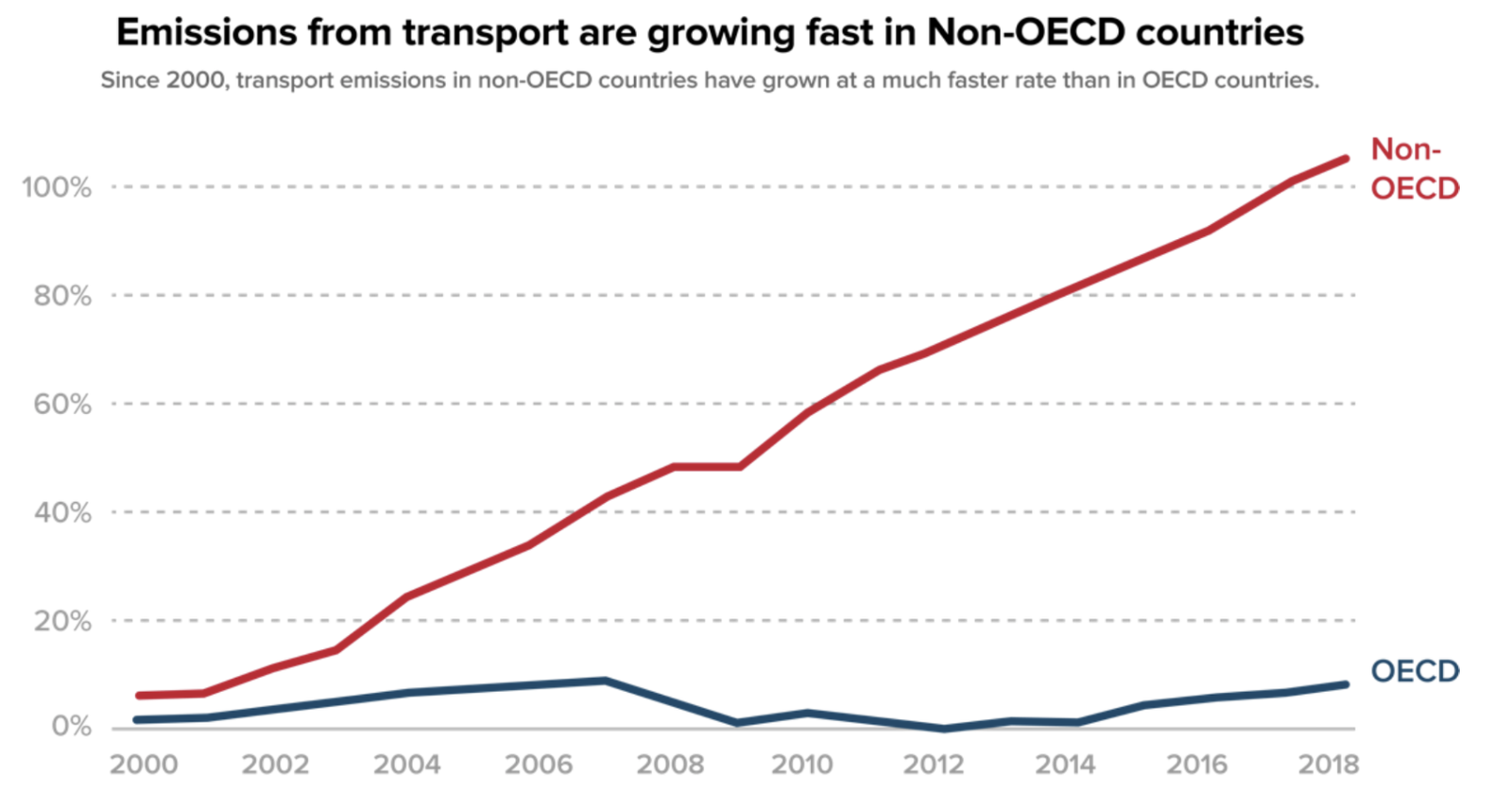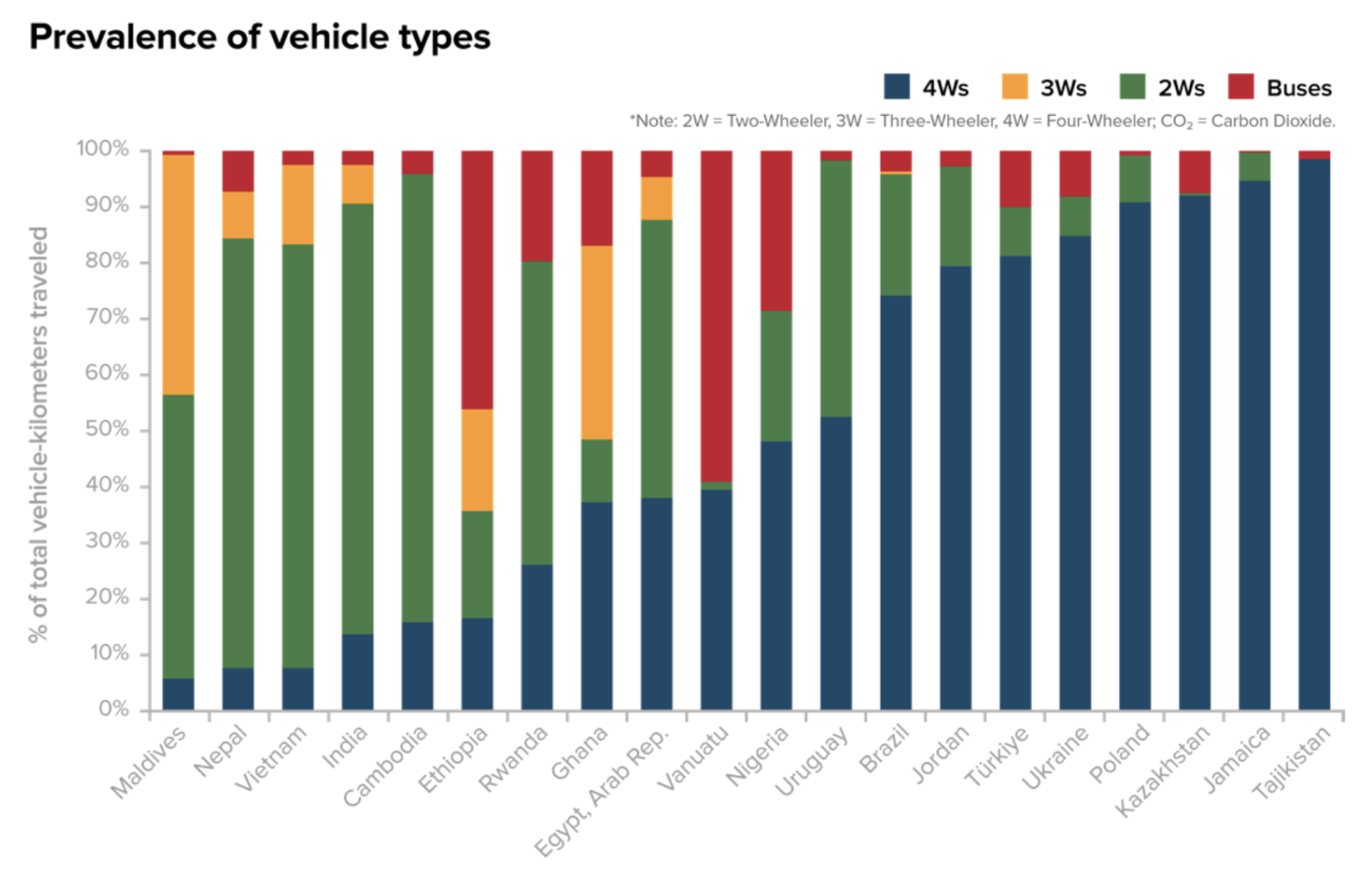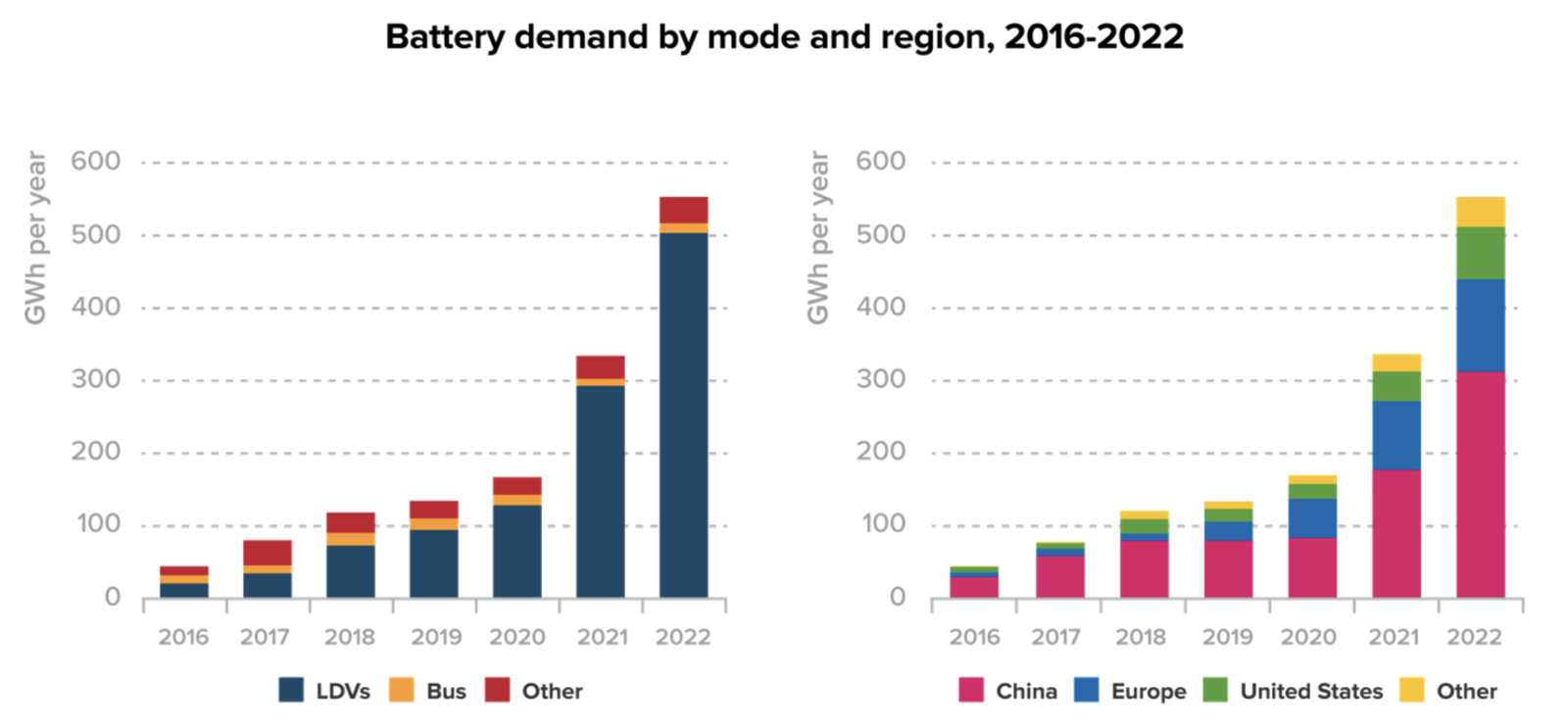· 9 min read
The e-mobility divide: Excluding China, the Global South is being left behind
Electric vehicles (EVs) continue to redefine global mobility, accelerating the shift towards a cleaner, more efficient energy future. In 2023, nearly one in five vehicles sold worldwide was electric. By 2035, electric vehicles are projected to make up almost 50% of the global auto market, signalling a transformative shift. As significant, China produces over half these EVs, reshaping the global automotive industry.
While these figures look encouraging, a staggering 95% of EV sales is in China, Europe and the United States. Developing and emerging markets (excluding China) still make up a fraction of sales. Even so, the transformative potential of the transition to e-mobility in these markets is vast – and on the way.
For countries in the Global South, a transition to e-mobility presents an opportunity to take another step towards building a sustainable future and realising SDG11 - promising both economic and environmental benefits. E-mobility improves health outcomes by reducing air pollution. This is a major concern in low- and middle-income countries, where 89% of the 4.2 million premature deaths due to outdoor air pollution occur each year. EVs also shift demand for oil, allowing nations that have traditionally relied on fossil fuels imports to rethink their energy dependencies. For example, in Small Island Developing States (SIDS), whose remote geographies lead to around 75% of imported oil being used for the transport sector, e-mobility can significantly reduce reliance on fossil fuel dependency and also reimagine tourism transportation - supporting green recovery; enhancing economic resilience and promoting environmental sustainability. This shift enhances energy security and buffers local populations against the volatility of gas and oil prices.
While the share of global sales of EVs in the Global South (excluding China) is small, markets are growing as emissions from the transport sector continue to rise rapidly (Figure 1). An EV produces 54% less in carbon dioxide emissions over its lifetime than a conventional internal-combustion vehicle. However, the magnitude of carbon reduction benefits becomes even graeater as power systems decarbonise, since the environmental benefits of EVs depend on the carbon intensity of electricity used for charging. By incorporating more renewable energy sources into power systems, EV emissions are expected to decrease by 25– 35%. By 2035, EV emissions could decline by 55–75%, correlating with a 50–65% reduction in the carbon intensity of electricity generation.
Against this backdrop, how can the Global South harness EVs to reimagine the future of their economies and developmental futures?

Figure 1: Emissions from transport in non-OECD countries (Source: World Bank)
Driving the mobility revolution: Electrifying shared transport
In the Global South, the vehicle mix varies significantly. Figure 2 shows that shared vans, minibuses, and two- and three-wheelers (2/3Ws) often outnumber personal cars due to their affordability and accessibility. An exciting opportunity emerges in electrifying this diverse vehicle mix. Tailoring electrification to local contexts and needs can both accelerate energy transitions and tackle last-mile mobility challenges, particularly in areas with inadequate public transport. A focus on shared electric vehicles, for example, rather than electric ‘personal cars’, promotes inclusive mobility, holding promise for reducing inequalities and improving well-being. In Sri Lanka, e-tuk-tuks (three-wheelers) are revitalising a form of widely affordable transportation essential for last-mile connectivity. They also ease financial burdens on three-wheeler owners, providing fuel cost savings during tough economic times.
Similarly, the adoption of electric buses over internal combustion engines (ICE), provides commuters across Asia, Africa, and Latin America and the Caribbean with accessible transport to reach jobs, healthcare and schools. In low-income communities, especially those with historically inadequate transport infrastructure, this has been a huge leap forward. From electric bus fleets in Chile and Colombia to electric two-wheelers in the Sahel region, EVs are facilitating development that is low-carbon, transformative and inclusive.

Figure 2: Prevalence of vehicle types (Source: World Bank)
Innovating for accessibility: An opportunity for EV adoption
The Global South faces unique complexities in adopting EV technologies. These vary on a case-by-case basis, often ranging from the price of vehicles, inadequate charging infrastructure and impacts on power systems. However, innovative solutions are emerging to address these issues. A rapid decline in battery pack pricing is making EVs more affordable – by 2024, the average cost of lithium-ion battery packs had fallen by 20%, reaching $115 per kilowatt-hour. Innovative charging solutions, like the community-built solar charging station in the Maldives, are powering EVs with renewable energy. Where electricity infrastructure is still evolving, there is a unique opportunity to design cleaner power systems alongside e-mobility solutions.
Digital technologies present further opportunities to lower charging and overall energy expenses, offering insights into trips, driving patterns, battery conditions and charging stations. Smart charging systems, for instance, help mitigate concerns about increased EV adoption leading to higher peak power demand. These systems optimise grid parameters, reducing power loss and peak demand by up to 96% compared to uncoordinated charging. Vehicle-to-grid (V2G) systems allow EVs to ease strains on grids by feeding electricity back into the grid. In addition, breakthroughs such as battery swapping stations permit quick battery replacements. Such approaches can enhance the economic viability of electric vehicles, especially in regions where upfront costs are a concern.
Scaling up investments: Transforming e-mobility financing in the Global South
Investments in EVs, particularly electric buses and two- and three-wheelers, are already economically justified in some countries, due to lower operating costs. Environmental benefits further enhance their appeal. To create a more favourable economic environment for e-mobility it is crucial to address and overcome legal and regulatory barriers while implementing direct and indirect incentives. Theses may include tax benefits, rebates, purchase support and subsidised charging at public stations. Preferential electricity rates, such as those outlined in Rwanda's e-mobility policy, could incentivise people to charge vehicles during off-peak hours, reducing grid strain and increasing the likelihood of EV adoption amid volatile/fluctuating fuel prices.
Expanding investment in electric public transport is essential, particularly in low-income countries, to improve access and affordability. Blended finance models could help de-risk investments and expand financing options. Market-shaping activities are also necessary to generate finance for critical infrastructure, charging, and energy capacity coverage. Innovative financing options such as those offered by E2W Africa, which issues affordable loans for two- and three-wheeler vehicles, reduce costs and facilitate easier scaling.
Fuelling the future: E-mobility as a catalyst for a just transition
As with any energy transition, the impending shift towards EVs is expected to have significant implications for employment. It could both cause job losses in the traditional ICE vehicle industry and create new opportunities in the EV sector. Under the UAE Consensus to triple renewable energy capacity and double energy efficiency improvements by 2030, EV manufacturing alone is expected to create 1.5 million new jobs (Figure 3). This presents an exciting opportunity to equip youth with the skills and knowledge to thrive in an evolving job market and to increase the entry of women and people from marginalised groups into the workforce. In Nepal, policies supporting electric ‘Tempos’ have significantly boosted the number of female drivers and vehicle-owning entrepreneurs; as women now represent nearly 60% of Tempo drivers. The Accelerating Investments in Low Emission Vehicles collaborative project in Uzbekistan successfully advocated for changing a policy that restricted women from driving heavier vehicles and buses.
A smooth transition to e-mobility requires up-skilling programmes that support the current workforce as well as retrofitting support for gas stations to double up as EV charging and service hubs. Government incentives and industry collaboration are crucial for a just transition that benefits the environment, the workers and everyone everywhere.

Figure 3: Global employment in vehicle manufacturing, EV battery production (Source: IEA 2023)
EVs and critical minerals: A double-edged sword for growth and sustainability
Rising demand for EVs is fuelling a surge in batteries. Demand for lithium-ion batteries, the predominant choice for EVs, has increased 65% from 2021–2022 (Figure 4). As a result, demand for critical minerals has also increased. In 2022, EV batteries drove approximately 60% of global demand for lithium, 30% for cobalt and 10% for nickel. Demand for critical minerals is projected to increase by three and half times by 2030, reaching over 30 million tonnes.

Figure 4: Battery demand by mode and region (Source: IEA)
Increased extraction of critical minerals in the Global South creates a number of developmental challenges and opportunities. Africa, for example, holds over 50% of global reserves and production of cobalt and manganese. Despite the vital role of critical minerals in government revenues, they are predominantly exported in raw forms, financially benefiting only a fraction of society. Maximising development gains requires advocating for upstream value addition, including through developing local capacities for refining and processing. Zimbabwe's Mines to Energy Park stands out as a prime example, positioning the country as a producer of lithium-ion batteries and allowing it to capitalise on its mineral reserves.
While extracting minerals generates fewer emissions than burning fossil fuels, it often exacerbates environmental issues. Mining has been a major contributor to the degradation of at least 700 million hectares and over 96 million hectares of land in Africa and India, respectively. Robust environmental legislation, regulation and policies are essential to mitigate such risks. For example, Rwanda’s mining law and policy framework guide environmental impact assessments and monitoring to mitigate the adverse effects of mining on ecosystems and local communities.
Beyond e-transport: Redefining sustainable urban mobility
Further safeguarding environmental integrity in e-transport calls for sustainable national waste management strategies and infrastructure. Circular approaches are important, such as utilising second-life batteries for stationary energy storage and adopting battery reuse and recycling practices. The latter can also increase local independence from international battery manufacturing hubs. Such strategies support both local economic growth opportunities and job creation. Moreover, integrating AI and digital technologies can optimise supply chains, enhancing material availability, and improving performance and efficiency in energy storage systems, including batteries
While e-mobility may not be the silver bullet to address all transport challenges, including congestion or accessibility, it undoubtedly brings a multitude of benefits and contributes significantly to both development and climate action goals. Ultimately, the focus must be to create sustainable urban mobility systems centred around public transport. This approach could help bridge the global divide in achieving SDG11, particularly its target to provide access to sustainable transportation for all. However, only once support for electrification, active mobility, micro-mobility solutions, green fleets and mobility-as-a-service becomes more mainstream will we see the necessary shift in energy and transport, one that would unlock broad development benefits for people around the world.
illuminem Voices is a democratic space presenting the thoughts and opinions of leading Sustainability & Energy writers, their opinions do not necessarily represent those of illuminem.






